Does your beloved cat have a habit of leaving behind undigested food on your carpet? It’s not only unpleasant to look at but can also be a sign of an underlying health issue. As a responsible cat owner, it’s crucial to understand the reasons why your cat may be throwing up undigested food.
While occasional vomiting is normal in cats, frequent regurgitation can indicate various health problems that require immediate attention. From hairballs and food intolerance to overeating and foreign objects, there are several reasons why your cat may be throwing up undigested food. In some cases, it could also be an indication of serious medical conditions like inflammatory bowel disease, pancreatitis or hyperthyroidism.
In this informative blog post, we’ll delve deeper into the possible causes of your cat’s vomiting and what you can do about it. We’ll also guide you on when it’s time to seek professional help from a vet for your furry friend’s well-being. So keep reading to discover what might be causing your cat’s regurgitation and how you can help them feel better.
Causes of Cats Throwing Up Undigested Food
While it’s not uncommon for cats to throw up occasionally, frequent episodes of vomiting undigested food can be a sign of an underlying health issue that needs attention. Understanding the various causes of cats throwing up undigested food can help you identify the problem and take steps to prevent it.
Eating Too Quickly
If so, it could be due to their eating habits. Eating too quickly is a common cause of vomiting undigested food in cats. But how exactly does this happen?
When cats eat too quickly, they tend to swallow large chunks of food without properly chewing it. This can cause the food to become lodged in their throat or esophagus, making it difficult for them to swallow or digest. As a result, your feline friend may regurgitate undigested food.
Furthermore, when cats eat too quickly, they also tend to swallow air along with their food. This can lead to bloating and discomfort as the air builds up in their stomach and puts pressure on their digestive system.
So, what can you do to prevent your cat from eating too quickly? One strategy is to provide smaller, more frequent meals throughout the day instead of one or two large meals. This encourages your cat to eat slower and helps prevent vomiting of undigested food.
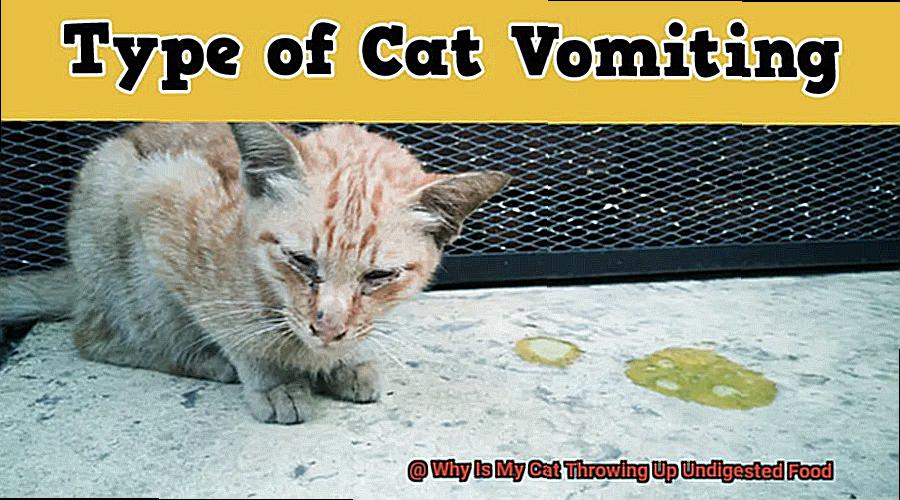
Another option is to monitor your cat’s eating habits closely and feed them smaller portions at a time. Alternatively, consider investing in a special bowl designed to slow down your cat’s eating pace. These bowls typically have ridges or obstacles that make it more challenging for your cat to eat too quickly, promoting better digestion and minimizing the risk of vomiting undigested food.
Hairballs
While scarfing down meals too quickly can be a common cause, hairballs can also be a culprit. But don’t worry, there are steps you can take to prevent and manage hairballs in your beloved feline.
When cats groom themselves, they inevitably swallow hair that can accumulate in their stomachs and form hairballs. These pesky balls of fur can irritate the stomach lining and cause vomiting, which may include undigested food. Cats with long hair or excessive shedding are particularly prone to hairballs. Additionally, cats that excessively groom themselves may develop more hairballs.
To prevent hairballs, regular grooming is crucial. This helps remove loose hairs and minimizes the amount of hair ingested by your cat. You can also use natural products that aid digestion and reduce the formation of hairballs. However, it’s always best to consult with your veterinarian before giving your cat any new supplements or products.
If your cat is frequently vomiting due to hairballs, it’s important to keep an eye on their behavior and appetite. If they seem lethargic or refuse to eat, it’s best to bring them to the vet for a check-up. In some cases, a hairball may become lodged in the digestive tract and require medical intervention.
By taking steps to reduce the formation of hairballs in your cat, you can help keep them healthy and content. Regular grooming and preventative products can go a long way in preventing undigested food from being vomited due to hairballs. Remember to always consult with your veterinarian if you have any concerns about your cat’s health or behavior.
Underlying Medical Conditions
Gastroenteritis is one common condition that could be causing your cat to vomit undigested food. This inflammation of the stomach and intestines can result from a viral or bacterial infection, parasites, or a change in diet. Keep a lookout for symptoms such as vomiting, diarrhea, and loss of appetite.
Another possible condition is pancreatitis, which occurs due to inflammation of the pancreas. This could be caused by various factors, including high-fat diets, certain medications, or infections. Symptoms of pancreatitis include vomiting, diarrhea, abdominal pain, and lethargy.
Other medical conditions that could lead to vomiting undigested food in cats include inflammatory bowel disease (IBD), kidney disease, liver disease, and thyroid problems. IBD is an inflammation of the digestive tract that can cause chronic vomiting and diarrhea. Kidney disease can cause vomiting due to a buildup of toxins in the bloodstream. Liver disease can cause vomiting due to a buildup of toxins in the liver. Thyroid problems can cause vomiting due to an overactive thyroid gland.
It’s essential to take your cat to the vet for a proper diagnosis and treatment plan if they are consistently vomiting undigested food. Your veterinarian may recommend changes in diet or medication to manage their condition effectively.
How to Prevent Cats From Throwing Up Undigested Food
Cats are notorious for eating quickly, which can lead to vomiting. To slow down your cat’s eating, try using a slow feeder bowl or spreading out their food on a flat surface. This will encourage them to eat slower and reduce the likelihood of regurgitation.
Monitor your cat’s diet
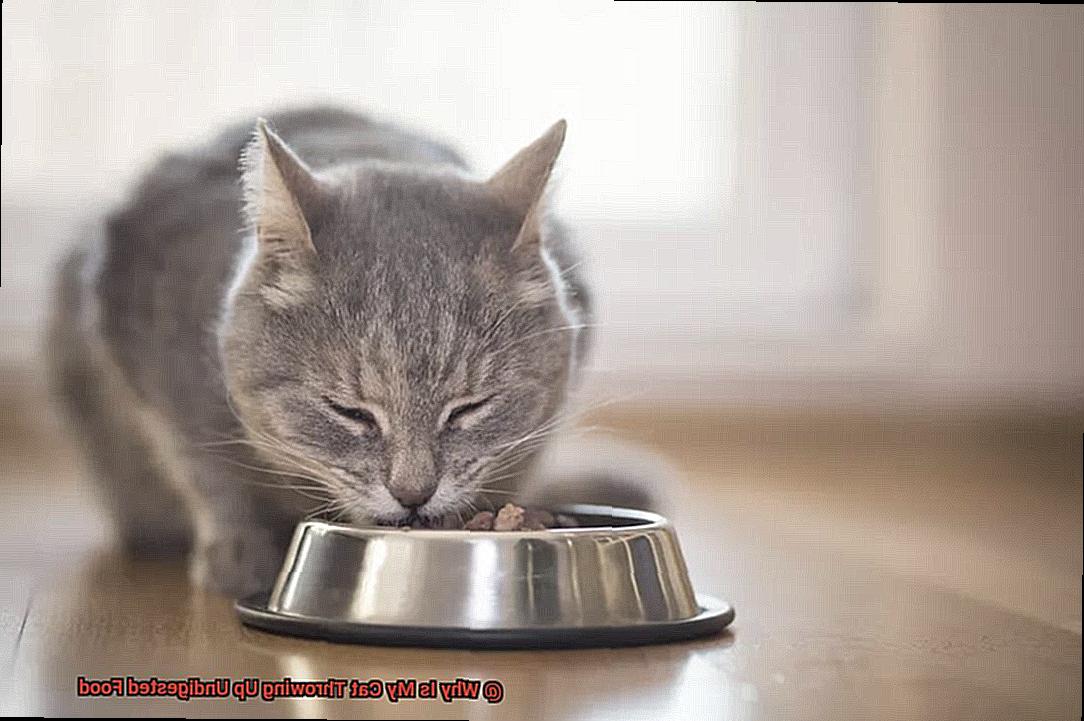
It’s essential to monitor your cat’s diet and make sure it’s appropriate for their age, weight, and health condition. Feeding them table scraps or human food can be difficult for their digestive system to process, leading to vomiting. If you suspect that your cat’s current diet is causing them to vomit, consult with a veterinarian to explore other options.
Make dietary changes gradually
When making dietary changes, it’s crucial to do it gradually over a period of one to two weeks. Abrupt changes in their diet can cause digestive upset and vomiting. Slowly introduce new foods or change the proportion of ingredients in their current diet.
Provide frequent small meals
Instead of feeding your cat one or two large meals per day, consider offering frequent small meals throughout the day. This will help prevent them from overeating and reduce the likelihood of vomiting.
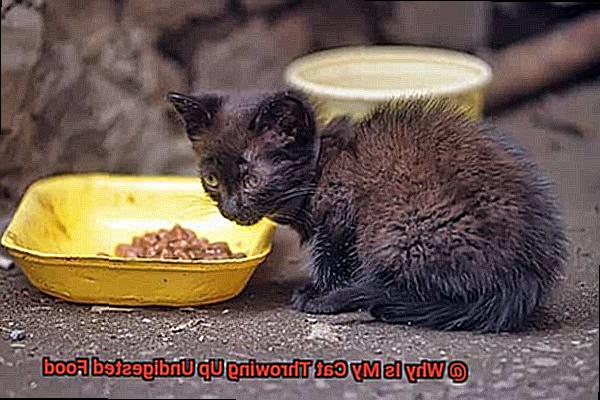
Reduce stress
Stress can cause digestive problems in cats, including vomiting. To reduce stress, provide your cat with a comfortable and safe environment, plenty of toys and activities, and spend quality time with them regularly. You can also try using pheromone sprays or diffusers to create a calming atmosphere.
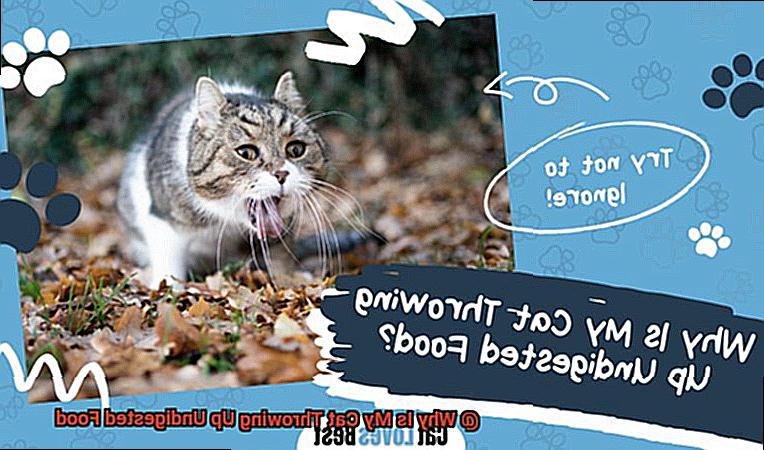
By following these tips, you can help prevent your cat from throwing up undigested food and ensure that they have a healthy and happy life. Remember, if your cat is frequently vomiting undigested food, it’s important to take them to a veterinarian for an examination and proper diagnosis.
Feeding Smaller Meals Throughout the Day to Prevent Vomiting
A simple strategy of feeding smaller meals throughout the day can help prevent this from happening.
The size of a cat’s stomach is small, and feeding them large meals can cause discomfort and induce vomiting. By breaking their daily meals into smaller portions and feeding them more frequently, you can help prevent this problem. This approach not only minimizes vomiting but also aligns with their natural grazing behavior. Cats are known to prefer small meals throughout the day rather than one or two large meals.
However, it’s essential to ensure that you’re still providing the right amount of food for your cat’s weight and activity level. Consult with your veterinarian to determine how much food your cat should consume daily and the optimal number of meals per day. As every cat is unique, your veterinarian will advise you on your cat’s specific dietary requirements.
Additionally, it’s crucial to pay attention to the type of food you’re feeding your cat. Some cats may have trouble digesting dry kibble, leading to vomiting. In such cases, wet food or a mix of wet and dry food may be a better option.
Feeding smaller meals throughout the day is an effective solution for cats who vomit undigested food.
Using Specialized Feeding Bowls to Slow Down Eating
Not only is this unpleasant for you, but it can also be uncomfortable and even dangerous for your cat. Fortunately, there is a simple solution that can prevent this issue: specialized feeding bowls.
These bowls come in various types, such as puzzle feeders, slow feeders, and interactive feeders. They are designed with ridges and mazes that force your cat to eat more slowly and take smaller bites. By doing so, they prevent your cat from gulping their food, which can lead to vomiting.
Puzzle feeders require your cat to work for their food by using their paws or nose to move obstacles around the bowl. Slow feeders have raised ridges or protrusions that make it difficult for your cat to scoop up large amounts of food at once. Interactive feeders have moving parts that require your cat to work for their food.
When using a specialized feeding bowl, it’s important to monitor your cat’s eating habits and adjust the amount of food accordingly. Some cats may become frustrated with the puzzle or interactive feeders, while others may need more time to finish their meal. Be patient and consistent in introducing new feeding methods.
In addition to preventing vomiting, using specialized feeding bowls can also help with weight management and promote healthy digestion. By slowing down your cat’s eating habits, they will feel fuller for longer periods of time, reducing overeating and snacking throughout the day.
Overall, using specialized feeding bowls is an effective way to promote healthy eating habits for your furry friend. Give it a try and see the difference it can make in your cat’s health and well-being.
Brushing Cats Regularly and Using Hairball Prevention Products
Fortunately, there are two simple steps you can take to prevent this issue: regular brushing and using hairball prevention products.
While cats are known for their fastidious grooming habits, they can sometimes ingest more hair than they can handle during grooming. This excess hair forms hairballs that can cause discomfort and vomiting for your cat. Regular brushing of your cat’s coat helps to remove loose hair that would otherwise be ingested while grooming.
But it’s crucial to use a gentle brush when grooming your cat, such as a soft bristle brush or a rubber grooming mitt, to avoid irritating its skin. Not only does brushing help prevent hairballs, but it also distributes your cat’s natural oils throughout its coat, keeping it healthy and shiny.
In addition to regular brushing, using hairball prevention products can also be effective. These products come in the form of treats, gels, and powders that contain ingredients like fiber and enzymes that aid in digestion and reduce the formation of hairballs.
However, it’s important to choose products that are specifically formulated for cats because some human remedies can be toxic to them. By incorporating these practices into your cat’s grooming routine, you can help keep your feline friend healthy and comfortable.
ZTejYOzJYlg” >
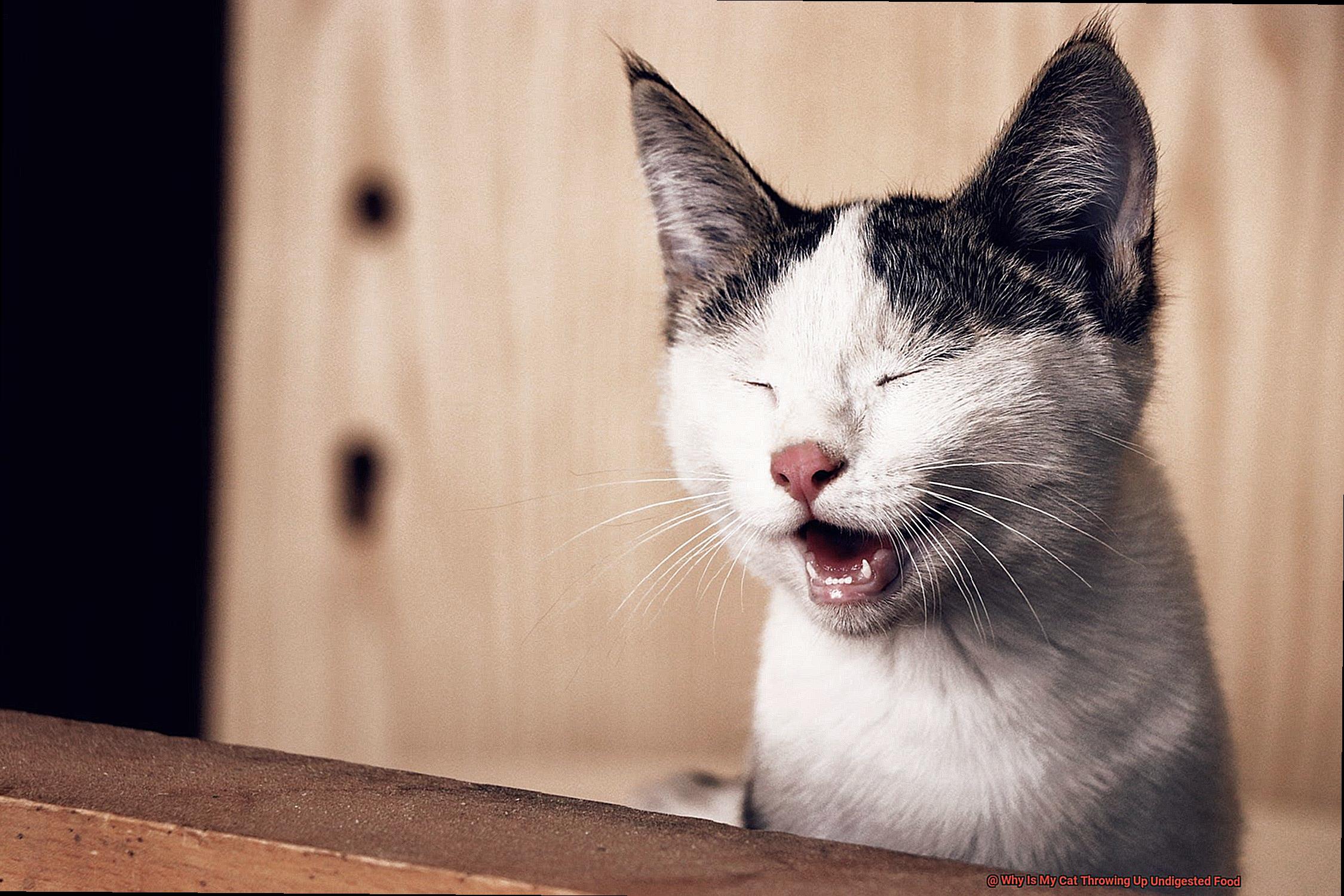
Taking Your Cat to the Vet for an Exam and Proper Diagnosis
Although it may seem like a minor issue, vomiting can be a sign of underlying health problems. That’s why taking your cat to the vet for an exam and proper diagnosis is crucial.
Your vet will conduct a thorough physical examination and inquire about your cat’s medical history during the exam. They may also run diagnostic tests like blood work or X-rays to pinpoint the cause of the vomiting. Getting a proper diagnosis is essential because it helps determine the best course of treatment for your cat.
Treatment options may include medication, changes in diet, or even surgery depending on the cause of the vomiting. Your vet will provide you with specific instructions on how to care for your cat and manage their condition.
Besides seeking professional help, you can do some things at home to help prevent vomiting in your cat. This includes feeding smaller meals throughout the day instead of one large meal, making sure they have access to plenty of water, and monitoring their behavior for any signs of illness.
Overall, taking your cat to the vet for an exam and proper diagnosis is vital when dealing with vomiting or any other medical issue. By working closely with your vet and following their recommendations, you can ensure that your cat stays healthy and happy for years to come. So, if you notice that your cat is vomiting frequently, don’t hesitate to make an appointment with your vet today.
Also Read: Why Do Cats Throw Up Their Food?
Conclusion
In summary, if you’ve noticed your feline friend frequently throwing up undigested food, it’s crucial to identify the underlying causes and take appropriate measures to prevent it. Although occasional vomiting is typical in cats, frequent regurgitation can be a sign of various health issues that require immediate attention. From hairballs and food sensitivities to overeating and foreign objects, there are numerous reasons why your cat may be experiencing this issue. In some cases, it could also indicate severe medical conditions like inflammatory bowel disease, pancreatitis or hyperthyroidism.
To prevent vomiting in cats, you can try feeding them smaller meals more often or using specialized feeding bowls designed to slow down their eating. Regular grooming and preventative products can also help prevent undigested food from being vomited due to hairballs. Additionally, reducing stress levels and monitoring your cat’s diet can aid with digestive problems.
It’s crucial to schedule an appointment with your vet for a proper diagnosis and treatment plan if your cat is consistently vomiting undigested food. Your vet may recommend dietary changes or medication to effectively manage their condition. By following these tips and working closely with your vet, you can ensure that your furry companion stays healthy and happy for years to come.







